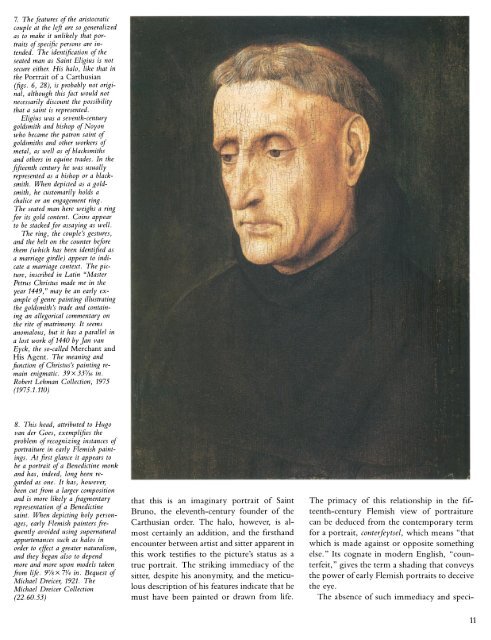Early Flemish Portraits 1425-1525: The Metropolitan Museum of Art ...
Early Flemish Portraits 1425-1525: The Metropolitan Museum of Art ...
Early Flemish Portraits 1425-1525: The Metropolitan Museum of Art ...
You also want an ePaper? Increase the reach of your titles
YUMPU automatically turns print PDFs into web optimized ePapers that Google loves.
7. <strong>The</strong> features <strong>of</strong> the aristocratic<br />
couple at the left are so generalized<br />
as to make it unlikely that portraits<br />
<strong>of</strong> specific persons are intended.<br />
<strong>The</strong> identification <strong>of</strong> the<br />
seated man as Saint Eligius is not<br />
secure either. His halo, like that in<br />
the Portrait <strong>of</strong> a Carthusian<br />
(figs. 6, 28), is probably not original,<br />
although thisfact would not<br />
necessarily discount the possibility<br />
that a saint is represented.<br />
Eligius was a seventh-century<br />
goldsmith and bishop <strong>of</strong> Noyon<br />
who became the patron saint <strong>of</strong><br />
goldsmiths and other workers <strong>of</strong><br />
metal, as well as <strong>of</strong> blacksmiths<br />
and others in equine trades. In the<br />
fifteenth century he was usually<br />
represented as a bishop or a blacksmith.<br />
When depicted as a goldsmith,<br />
he customarily holds a<br />
chalice or an engagement ring.<br />
<strong>The</strong> seated man here weighs a ring<br />
for its gold content. Coins appear<br />
to be stackedfor assaying as well.<br />
<strong>The</strong> ring, the couple's gestures,<br />
and the belt on the counter before<br />
them (which has been identified as<br />
a marriage girdle) appear to indicate<br />
a marriage context. <strong>The</strong> picture,<br />
inscribed in Latin "Master<br />
Petrus Christus made me in the<br />
year 1449," may be an early example<br />
<strong>of</strong> genre painting illustrating<br />
the goldsmith's trade and containing<br />
an allegorical commentary on<br />
the rite <strong>of</strong> matrimony. It seems<br />
anomalous, but it has a parallel in<br />
a lost work <strong>of</strong> 1440 by Jan van<br />
Eyck, the so-called Merchant and<br />
His Agent. <strong>The</strong> meaning and<br />
function <strong>of</strong> Christus's painting re-<br />
main enigmatic. 39x 337/6 in.<br />
Robert Lehman Collection, 1975<br />
(1975.1.110)<br />
8. This head, attributed to Hugo<br />
van der Goes, exemplifies the<br />
problem <strong>of</strong> recognizing instances <strong>of</strong><br />
portraiture in early <strong>Flemish</strong> paintings.<br />
At first glance it appears to<br />
be a portrait <strong>of</strong> a Benedictine monk<br />
and has, indeed, long been regarded<br />
as one. It has, however,<br />
been cut from a larger composition<br />
and is more likely a fragmentary<br />
representation <strong>of</strong> a Benedictine<br />
saint. When depicting holy personages,<br />
early <strong>Flemish</strong> painters frequently<br />
avoided using supernatural<br />
appurtenances such as halos in<br />
order to effect a greater naturalism,<br />
and they began also to depend<br />
more and more upon models taken<br />
from life. 97/8 71/4 in. Bequest <strong>of</strong><br />
Michael Dreicer, 1921. <strong>The</strong><br />
Michael Dreicer Collection<br />
(22.60.53)<br />
that this is an imaginary portrait <strong>of</strong> Saint <strong>The</strong> primacy <strong>of</strong> this relationship in the fif-<br />
Bruno, the eleventh-century founder <strong>of</strong> the teenth-century <strong>Flemish</strong> view <strong>of</strong> portraiture<br />
Carthusian order. <strong>The</strong> halo, however, is al- can be deduced from the contemporary term<br />
most certainly an addition, and the firsthand for a portrait, conterfeytsel, which means "that<br />
encounter between artist and sitter apparent in which is made against or opposite something<br />
this work testifies to the picture's status as a else." Its cognate in modern English, "countrue<br />
portrait. <strong>The</strong> striking immediacy <strong>of</strong> the terfeit," gives the term a shading that conveys<br />
sitter, despite his anonymity, and the meticu- the power <strong>of</strong> early <strong>Flemish</strong> portraits to deceive<br />
lous description <strong>of</strong> his features indicate that he the eye.<br />
must have been painted or drawn from life. <strong>The</strong> absence <strong>of</strong> such immediacy and speci-<br />
11

















